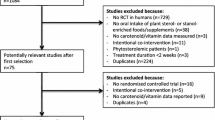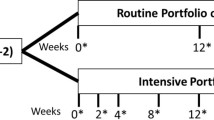Abstract
The ability of plant sterol esters (PSE) in salad dressing to modify plasma lipids and carotenoids was determined in 26 men and 27 women fed controlled, weight-maintaining, isocaloric diets. Diets contained typical American foods that provided 32% of energy from fat. Dressings contained 8 g (ranch) or 4 g (Italian) of fat per serving. PSF (3.6 g/d) were provided in two servings/d of one of the dressings. Diets with ranch or Italian dressing without and with PSE were fed for 3 wk/diet and crossed over randomly within dressings. Diets were adjusted to similar fat and fatty acid concentrations. Type of salad dressing did not affect plasma lipids, lipoproteins, carotenoids, or fat-soluble vitamins (P>0.05). Switching from a self-selected baseline diet to the control diet resulted in reduction in low density lipoprotein (LDL) cholesterol of 7.9%, a decrease in high density lipoprotein (HDL) cholesterol of 3.1%, and a decrease in triglycerides (TG) of 9.3%. Consumption of 3.6 g of PSE resulted in further decreases in LDL cholesterol (9.7%) and TG (7.3%) but no additional change in HDL cholesterol. Total plasma carotenoids decreased 9.6% with PSE. An automated stepwise procedure was developed to produce candidate mixed models relating plasma carotenoid response to PSE. These models adjusted for preintervention plasma carotenoid levels and effects of diets on blood lipids. There were significant decreases in β-carotene, α-carotene, and β-cryptoxanthin (females only) not associated with changes in plasma lipids. Plasma carotenoids on all diets remained within normal ranges. We conclude that low-fat foods, such as salad dressings, are effective carriers for PSE.
Similar content being viewed by others
Abbreviations
- ANOVA:
-
analysis of variance
- Apo A1:
-
apolipoprotein A1
- Apo B:
-
apolipoprotein B
- BHNRC:
-
Beltsville Human Nutrition Research Center
- BIC:
-
Schwartz's Bayesian information criteria
- BMI:
-
body mass index
- CVD:
-
cardiovascular disease
- HDL:
-
ligh density lipoprotein
- HPLC:
-
high-performance liquid chromatography
- LDL:
-
low density lipoprotein
- Lp(a):
-
lipoprotein (a)
- NCEP:
-
National Cholesterol Education Program
- PSE:
-
plant sterol esters
- SEE:
-
standard error of the estimated or corrected mean
- SEM:
-
standard error of the mean
- SFA:
-
saturated fatty acid
- TC:
-
total cholesterol
- TG:
-
triglycerides
- USDA:
-
U.S. Department of Agriculture
References
Dietary Guidelines Advisory Committee (2000) Report of the Dietary Guidelines Advisory Committee on the Dietary Guidelines for Americans, 2000, U.S. Department of Agriculture, Agricultural Research Service, Beltsville MD.
Pollak, O.J., and Kritchevsky, D. (1981) Sitosterol (Monographs on Atherosclerosis, Vol. 10), Karger, Basel.
de Vries, J.H.M., Kromhout, J.A., van de Bovenkamp, P., van Straveren, W.A., Mensink, R.P., and Katan, M.B. (1997) The Fatty Acid and Sterol Content of Food Composites of Middle-Aged Men in Seven Countries, J. Food Comp. Anal. 10, 115–141.
Weststrate, J.A., and Meijer, G.W. (1998) Plant Sterol-Enriched Margarines and Reduction of Plasma Total-and LDL-Cholesterol Concentrations in Normocholesterolaemic and Mildly Hypercholesterolaemic Subjects, Eur. J. Clin. Nutr. 52, 334–343.
Hendriks, H.F.J., Weststrate, J.A., van Vliet, T., and Meijer, G.W. (1999) Spreads Enriched with Three Different Levels of Vegetable Oil Sterols and the Degree of Cholesterol Lowering in Normocholesterolaemic and Mildly Hypercholesterolaemic Subjects, Eur. J. Clin. Nutr. 53, 319–327.
Society of Actuaries and Association of Life Insurance Medical Directors of America 1979 (1980) Weight of Insured Persons in the United States Associated with Lowest Mortality, Association of Life Insurance Medical Directors of America, Philadelphia.
U.S. Department of Agriculture, Agricultural Research Service (1998) USDA-NCC Carotenoid Database for U.S. Foods—1998, Nutrient Data Laboratory Home Page, http://www.nal.usda.gov/fnic/foodcomp.
National Heart Lung and Blood Institute (1982) Lipid and Lipoprotein Analysis, in Manual of Laboratory Operations, Lipid Research Clinics Program (Hainline, A., Karon, J., and Lippel, K., eds.), 2nd edn., Department of Health and Human Services, Bethesda, MD.
Gidez, L.I., Miller, G.J., Burstein, M., Slagle, S., and Eder, H.A. (1982) Separation and Quantitation of Subclasses of Human Plasma High-Density Lipoproteins by a Simple Precipitation Procedure, J. Lipid Res. 23, 1206–1223.
Friedewald, W.T., Levy, R.I., and Fredrickson, D.S. (1972) Estimation of the Concentration of Low-Density Lipoprotein Cholesterol Without Use of the Preparative Ultracentrifuge, Clin. Chem. 18, 499–502.
Khachik, F., Beecher, G.R., Goli, M.B., Lusby, W.R., and Smith, J.C. (1992) Separation and Identification of Carotenoids and Their Oxidation Products in the Extracts of Human Plasma, Anal. Chem. 64, 2111–2122.
Bieri, J.G., Brown, E.D., and Smith, J.C. (1985) Determination of Individual Carotenoids in Human Plasma by High Performance Liquid Chromatography, J. Liq. Chromatogr. 8, 473–484.
Burnham, K.P., and Anderson, D.R. (1998) Model Selection and Inference; A Practical Information-Theoretic Approach, Springer-Verlag, New York.
Littell, R.C., Milliken, G.A., Stroup, W.W., and Wolfinger, R.D. (1996), SAS System for Mixed Models, SAS Institute, Inc., Cary, NC.
Schwartz, G. (1978) Estimating the Dimension of a Model, Ann. Statistics 6, 461–464.
Clevidence, B.A., and Bieri, J.G. (1993) Association of Carotenoids with Human Plasma Lipoproteins, Methods Enzymol. 214.
U.S. Department of Agriculture, Agricultural Research Service, (1996) Data Tables: Results for USDA's 1995 Continuing Survey of Food Intakes by Individuals and 1995 Diet and Health Knowledge Survey, Beltsville Human Nutrition Research Center, Food Surveys Research Group, Beltsville, MD.
U.S. Department of Agriculture, Human Nutrition Information Service (1976-1990) Composition of Foods, Agriculture Handbook No. 8, Sections 1–22, U.S. Government Printing Office, Washington, DC.
Miller, G.J., and Miller, N.E. (1975) Plasma High-Density Lipoprotein Concentration and Development of Ischemic Heart Disease, Lancet i, 16–20.
Gordon, D.J., Probstfield, J.L., Garrison, R.J., Neaton, J.D., Castelli, W.P., Knoke, J.D., Jacobs, D.R., Jr., Bangdiwala, S., and Tyroler, H.A. (1989) High-Density Lipoprotein Cholesterol and Cardiovascular Disease: Four Prospective American Studies, Circulation 79, 8–15.
Lichtenstein, A.H., Ausman, L.M., McNamara, J.R., and Schaefer, E.J. (1996) Trans and Saturated Fatty Acid Content of Dietary Fat Effects Plasma Lipid and Lipoprotein Concentrations, Circulation 94, 1–97.
Chisholm, A., Mann, J., Sutherland, W., Duncan, A., Skeaff, M., and Frampton, C. (1996) Effect on Lipoprotein Profile of Replacing Butter with Margarine in a Low Fat Diet: Randomized Crossover Study with Hypercholesterolaemic Subjects, Br. Med. J. 312, 931–934.
Hokanson, J.E., and Austin, M.A. (1996) Plasma Triglyceride Level Is a Risk Factor for Cardiovascular Disease Independent of High-Density Lipoprotein Cholesterol Level: A Meta-analysis of Population-Based Prospective Studies, J. Cardicvasc. Risk 3, 213–229.
Bostom, A.G., Gagnon, D.R., Cupples, L.A., Wilson, P.W.F., Jenner, J.L., Ordovas, J.M., Schaefer, E.J., and Castelli, W.P. (1994) A Prospective Investigation of Elevated Lipoprotein(a) Detected by Electrophoresis and Cardiovascular Disease in Women: The Framingham Heart Study, Circulation 90, 1688–1695.
Schaefer, E.J., Lamon-Fava, S., Jenner, J.L., McNamara, J.R., Ordovas, J.M., Davis, E., Abolafia, J.M., Lippel, K., and Levy, R.I. (1994) Lipoprotein (a) Levels and Risk of Coronary Heart Disease in Men: The Lipid Research Clinics Coronary Primary Prevention Trial, J. Am. Med. Assoc. 271, 999–1003.
Hoefler, G., Harnoncourt, F., Paschke, E., Mirtl, W., Pfeiffer, K.H., and Kostner, G.M. (1988) Lipoprotein Lp(a): A Risk Factor for Myocardial Infarction, Arteriosclerosis 8, 398–401.
Rosengren, A., Wilhelmsen, L., Eriksson, E., Risberg, B., and Wedel, H. (1990) Lipoprotein (a) and Coronary Heart Disease: A Prospective Case-Control Study in a General Population Sample of Middle Aged Men, Br. Med. J. 301, 1248–1251.
Clevidence, B.A., Judd, J.T., Schaefer, E.J., Jenner, J.L., Lichtenstein, A.H., Muesing, R.A., Wittes, J.A., and Sunkin, M.E. (1997) Plasma Lipoprotein(a) Levels in Men and Women Consuming Diets Enriched in Saturated, cis or trans, Monounsaturated Fatty Acids, Arterioscler. Thromb. Vasc. Biol. 17, 1–5.
Almendingen, K., Jordal, O., Kierulf, P., Sandstad, B., and Pedersen, J.I. (1995) Effects of Partially Hydrogenated Fish Oil, Partially Hydrogenated Soybean Oil, and Butter on Serum Lipoproteins and Lp(a) in Men, J. Lipid Res. 36, 1370–1384.
Judd, J.T., Baer, D.J., Clevidence, B.A., Muesing, R.A., Chen, S.C., Weststrate, J.A., Meijer, G.W., Wittes, J., Lichtenstein, A.H., Vilella-Bach, M., and Schaefer, E.J. (1998) Effects of Margarine Compared with Those of Butter on Blood Lipid Profiles Related to Cardiovascular Disease Risk Factors in Normolipemic Adults Fed Controlled Diets, Am. J. Clin. Nutr. 68, 768–777.
Mensink, R.P., Zock, P.L., Katan, M.B., and Hornstra, G. (1992) Effect of Dietary cis and trans Fatty Acids on Serum Lipoprotein(a) Levels in Humans, J. Lipid Res. 33, 1493–1501.
Nestel, P., Noakes, M., Belling, B., McArthur, R., Clifton, P., Janus, E., and Abbey, M. (1992) Plasma Lipoprotein Lipid and Lp(a) Changes with Substitution of Elaidic Acid for Oleic Acid in the Diet, J. Lipid Res. 33, 1029–1036.
Normen, L., Dutta, P., Lia, A., and Andersson, H. (2000) Soy Sterol Esters and β-Sitostanol Ester as Inhibitors of Cholesterol Absorption in Human Small Bowel, Am. J. Clin. Nutr. 71, 908–913.
National Cholesterol Education Program (1994) Second Report of the Expert Panel on Detection, Evaluation, and Treatment of High Blood Cholesterol in Adults (Adult Treatment Panel II), Circulation 89, 1329–1445.
National Cholesterol Education Program (2001) Executive Summary: Third Report of the Expert Panel on Detection, Evaluation, and Treatment of High Blood Cholesterol in Adults (Adult Treatment Panel III), J. Am. Med. Assoc. 285, 2486–2497.
Author information
Authors and Affiliations
Corresponding author
About this article
Cite this article
Judd, J.T., Baer, D.J., Chen, S.C. et al. Plant sterol esters lower plasma lipids and most carotenoids in mildly hypercholesterolemic adults. Lipids 37, 33–42 (2002). https://doi.org/10.1007/s11745-002-0861-y
Received:
Revised:
Accepted:
Issue Date:
DOI: https://doi.org/10.1007/s11745-002-0861-y




